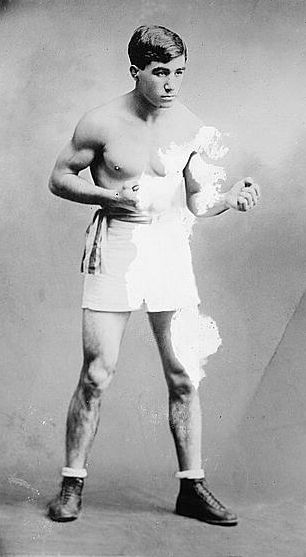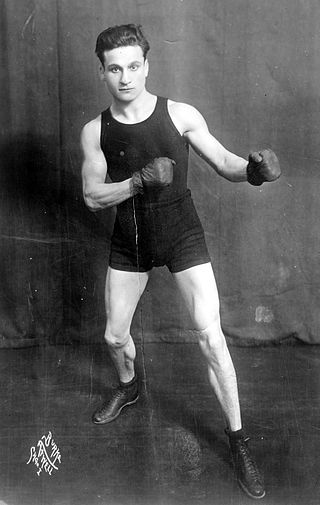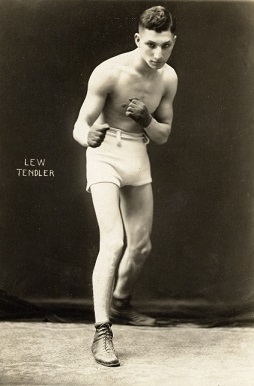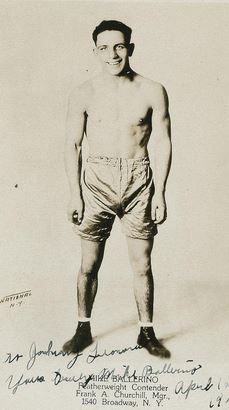
Reuven "Ruby" Goldstein, the "Jewel of the Ghetto", was an American boxer and prize fight referee. He was a serious World Lightweight Championship contender in the 1920s, and became one of U.S. most trusted and respected boxing referees in the 1950s. During his boxing career, he was trained and managed by Hymie Cantor.

Johnny "The Scotch Wop"Dundee was an American featherweight and the first world junior lightweight champion boxer who fought from 1910 until 1932. He was inducted into the Ring Magazine Hall of Fame in 1957 and the International Boxing Hall of Fame class of 1991.

Charley White was an English-American boxer from Chicago, Illinois. Viewed by many as one of the best of his era, he fought from 1906 until 1923. He also lost a comeback match in 1930 against Henry Perlick, where he threw his famous left hook but Perlick countered with a right cross, knocking him down.

Rocky Kansas was an Italian-born American tough, short former world lightweight champion boxer. He was born Rocco Tozzo on April 21, 1893, in Italy and came to America in 1898. Rocky Kansas was the brother of champion Joe "Kid" Kansas whom he combined with at an attempt to become a champion in 1938.

Sammy Mandell was an American World lightweight boxing champion from 1926-1930. Born in Rockford, Illinois, and named Salvatore Mandala, he was known as the "Rockford Sheik" due to his Rudolph Valentino like good looks and as the "Rockford Flash" due to his fast hands and foot speed. His father was an Albanian and his mother Italian. Statistical boxing website BoxRec ranks Mandell as the 13th greatest lightweight boxer to have ever lived. He was inducted into the International Boxing Hall of Fame in 1998.

Benny Valgar, frequently spelled "Valger", was a French boxer. On February 25, 1920, he faced the reigning featherweight champion, Johnny Kilbane, in a 8-round non-title bout which, without a disqualification or knockout, had no official winner. According to all of newspaper writers who reported on the fight, Valgar won convincingly. Due to the fighters being over the featherweight limit of 124 pounds, the fight was not for Kilbane's championship. Kilbane could have waved the forfeit, but chose not to.

Louis "Kid" Kaplan, known as the Meridan Buzzsaw, was a professional boxer and a 1925 world featherweight champion.

Al "The Bronx Beauty" Singer was an American boxer who won the world lightweight championship in 1930.

Benjamin "Benny" Baruch J. Bass, known as "Little Fish", was an American boxer. He was born in Kyiv, Ukraine, with his family emigrating to the United States in 1906; choosing to settle in Philadelphia, Pennsylvania. Bass was world featherweight champion and world junior lightweight champion during his career. Statistical boxing website BoxRec lists Bass as the #17 ranked lightweight of all time. He was inducted into the International Jewish Sports Hall of Fame in 1994 and the International Boxing Hall of Fame in 2002. Strongly built with muscular shoulders, Bass's signature punch was a powerful left hook to the midsection, and he enjoyed fighting on the inside, a frequent requirement from his relative lack of reach.

Jack Bernstein was an American boxer given the birthname John Dodick. He became World Junior lightweight Champion, on May 30, 1923, against Johnny Dundee at the Coney Island Velodrome in Brooklyn. When he lost the title to Dundee on December 17, 1923, in a fifteen-round split decision at Madison Square Garden, many newspapers felt Bernstein clearly had the edge in the bout and should have retained the title.

Harry Lewis, was an American boxer, generally credited with holding the Welterweight Championship of the World from April 1908 to March 1911. He defeated "Young Joseph", the reigning Welterweight Champion of England in London on June 27, 1910, but was not credited with the British Welterweight championship as the fight was sanctioned as a World, and not English title. Boxing writer Nat Fleischer rated Lewis the sixth-greatest welterweight of all time. He was inducted into the International Jewish Sports Hall of Fame in 2002, and into the International Boxing Hall of Fame in 2008.

"Lefty" Lew Tendler was an American boxer. He is generally considered one of the best boxers to never have won a world title, though he was a top rated contender for both the world light and welterweight championships.
Sidney Terris was a top rated American lightweight boxing contender from the lower East Side of Manhattan. He excelled as an amateur, winning fifty straight bouts and taking Metropolitan, New York State, National AAU, and both National and International titles.

James Bryan Herring, also known as Red Herring, was an American boxer, who claimed the world light welterweight championship in 1925.

Memphis Pal Moore was an American boxer from Memphis, Tennessee, who claimed the World Bantamweight Championship in 1918 defeating championship claimant Johnny Ertle in Baltimore. He was rated as the seventeenth best bantamweight of all time by boxing.com, and was elected to the International Boxing Hall of Fame in 2010.
Joe Glick (1903-1978) was an American boxer from Brooklyn who established himself early as a top contender among junior lightweights. He had two Junior Lightweight Title shots against Tod Morgan in 1926–27, but was unable to take the championship. Moving up in weight class, he also excelled as a Lightweight. His long career spanned twenty-three years and included over two hundred verified bouts.

Jack Silver was a Navy Pacific Fleet Champion around 1921, a Pacific Coast Lightweight boxing Champion in 1924 and a contender for the Pacific Coast Welterweight Championship in 1926.

Jimmy Goodrich became the World Lightweight Champion when he defeated Chilean boxer Stanislaus Loayza in a second round TKO at Queensboro Stadium in Queens, New York on July 13, 1925. He retained the title only five months, losing it by unanimous decision to Rocky Kansas on December 7, 1925. Goodrich was known for having never been the victim of a knockout.

Joe Benjamin was an American boxer. He was a Pacific Coast Featherweight Boxing Champion in 1915 and a 1922 World Junior Lightweight Boxing Championship contender against Johnny Dundee. In his fifty-one reported wins on BoxRec, he had nineteen by knockout, giving him an impressive knockout ratio.

Mike Ballerino was an American World Jr. Lightweight boxing champion who began his career in the Philippines boxing with the U. S. Army. Ballerino took the World Jr. Lightweight Championship against Steve "Kid" Sullivan on April 1, 1925, in Philadelphia, Pennsylvania, in a ten-round unanimous decision.



















